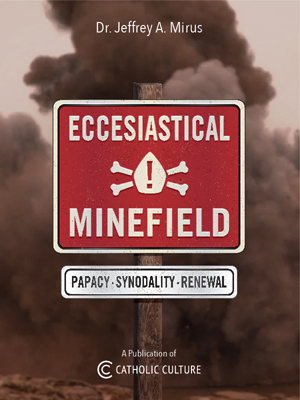Our Lady of Guadalupe: the stories behind the story
By Phil Lawler ( bio - articles - email ) | Apr 30, 2024
The Twelve Apostles, inspired by the Holy Spirit at Pentecost, drew thousands to the Christian faith within a matter of hours. But spectacular as their successes were, their first harvest of converts could not compare to the astonishing yield in Mexico in the 1530s, when somewhere between nine and ten million converts entered the Church within a few years.
The credit for that unparalleled missionary success, of course, goes to Our Lady of Guadalupe, who appeared to St. Juan Diego at Tepeyac in 1531. (When he launched a novena of prayer for a rebirth of faith, to combat “the darkness of our age,” Cardinal Raymond Burke placed his crusade under the patronage of Our Lady of Guadalupe in recognition of her unique power.) But there is a fascinating story behind the Gaudalupe phenomenom. That story is told in a new book, Guadalupe and the Flower World Prophecy, by a married couple, Joseph Julian and Monique Gonzalez.
To appreciate the sensational success of the Franciscan missionaries after 1531, one must understand that before the Our Lady’s appearance, they had been frustrated in their efforts to evangelize the indigenous peoples. Bishop Juan de Zumarraga—to whom Juan Diego would bring the flowers that bloomed miraculously, out of season, on the Tepeyac hill—had written to Rome to report that the natives seemed unusually resistant to the Gospel. The friars had trouble communicating in the native language, but even more trouble understanding the native culture.
The native tribes were pagan, and many aspects of their culture were brutal: human sacrifice, slavery, polygamy. Yet that same culture also had a rich tradition of poetry, song, and speculation about the supernatural and the afterlife. For centuries the people had heard and memorized songs that told of a glorious place, characterized by lush fragrant flowers and the singing of beautiful birds, where at last a soul could find true happiness. This place, which the Gonzalez book calls the Flower World Paradise, was ruled by “the God of Near and Far,” and could only be reached by someone who was worthy, someone who was pure.
The most famous of the native songs, the Cuicapeuhcayotl begins: “I ponder within my heart, where will I gather the fragrant flowers?” This longing for the Flower World Paradise, a longing for the perfect life, in harmony with the universe, was passed down through the generations. It was their faith, the basis of their culture, and they resisted the Franciscans’ attempts to introduce a different faith.
And then came the report that Juan Diego had brought beautiful flowers from a hill, where he had heard the signing of birds, where miracles had taken place. His story matched the old myths. And while he was a humble common man, Juan Diego was a Christian; he had been baptized. Although few of them had accepted the missionaries’ teaching, they had heard that Baptism purifies the soul. So Juan Diego fit the role of the pure man, the man who was worthy to enter the Flower World Paradise. Soon there were new songs to be sung in the native communities, telling about this remarkable event, putting it in the context of the old myths.
The Gonzalez book introduces the possibility that the old myths had been planted in the culture of the Mexican tribes long ago, through the inspiration of the Holy Spirit, to prepare them for the Gospel message:
While it is the general belief that the tilma alone caused all the conversions throughout the land, we would like to approach it within its larger context, understanding that belief in the tilma is predicated on belief in the story.
And why not? The Gonzalez book recalls the principle of preparatio evangelica: the understanding that God prepares people, in various ways, to accept his Word. He prepared the people of Israel for the Messiah. His prophets wrote about Jesus in images that could only be fully understood after the Resurrection. The Catholic Church enjoys the guidance of the Holy Spirit, but not a monopoly on the Spirit’s inspiration. Read Guadalupe and the Flower World Prophecy, with the authors’ meticulous accounts of the native culture, the flower songs, and the many points at which the old myths match the new story that arose from Guadalupe. They make a very strong case.
Whether the tsunami of conversions was due to the tilma or the flower songs (along with the Virgin’s maternal care), the results are undeniable. The friars who had been struggling to win an occasional convert now found the courtyards of their missions packed with people demanding Baptism. The natives traveled for miles, bringing their pagan idols to be burned, accepting penances, regularizing their marriages. The Franciscans now were struggling to cope with the intense desire for the sacraments; they experimented with mass baptism ceremonies (until the Vatican barred the practice) simply to keep up with the demand.
Many years later, a skeptical student of the native culture, noticing the marked similarities between the Guadalupe story and the flower-song tradition, concluded that the Franciscans had deliberately shaped their narrative of the apparitions to appeal to the natives’ ideas. There’s just one problem with that theory. At the time of Our Lady’s appearance, the friars had not yet discovered the flower-song tradition. The native language was too difficult, the allusions were too obscure. The first accounts of Our Lady’s appearances to Juan Diego were written long before the Franciscans understood the native tradition.
All comments are moderated. To lighten our editing burden, only current donors are allowed to Sound Off. If you are a current donor, log in to see the comment form; otherwise please support our work, and Sound Off!








